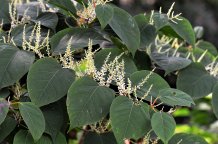Articles

Plants that have become invasive outside their native range include Japanese knotweed
Breakthrough in battle against invasive plants
Plants that can “bounce back” after disturbances like ploughing, flooding or drought are the most likely to be “invasive” if they’re moved to new parts of the world, scientists say.
Invasive plants cause harm to people, industry, livestock, wildlife and natural ecosystems worldwide – but predicting which plants could become invasive is very difficult.
A team of scientists from across Europe, led by the University of Exeter, developed and analysed a global database of plant life cycles to tackle this puzzle.
“What we found was a real surprise,” said senior author Professor Dave Hodgson, from the University of Exeter.
“Invasive plant populations grow fast in their invaded range, but not in their native range. So you can’t use population growth to predict invasiveness.
“However, invasive plant species have an amazing ability to bounce back from disturbances, and we can see this in both their native range and their invaded range.
“Based on this finding, we should avoid the export of plant species that grow well in disturbed environments.”
PhD student and ecological consultant Kim Jelbert, lead author of the paper, said: “The kinds of species that bounce back from disturbance tend to be species that produce lots of seeds from large flowers.
“This is a real problem, because large flowers are popular with gardeners all over the world. These species should not be traded internationally.
“We also discovered patterns of ancestry. Close relatives of invasive plants are also likely to be invasive if they escape their native range.”
Plant species are transported all over the world by the gardening, food and flower industries – with many exported from their native (home) range.
Professor Hodgson added: “The global battle against invasive species is made difficult because we have failed until now to predict which species will be a problem, and which will be benign, when they colonise new regions.
“For the first time, we have a strong clue to the identity of future invasive plants.
“Weedy plants of disturbed environments – and their close relatives – should not be exported.”
Plants that have been moved outside their native range and become invasive include Japanese knotweed, blackberry and Himalayan balsam.
The research, funded by the Natural Environment Research Council and published in the journal Nature Communications, is entitled: “Demographic amplification is a predictor of invasiveness among plants.”
Date: 6 December 2019
